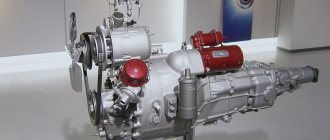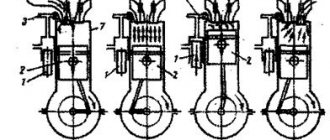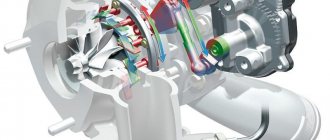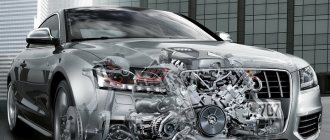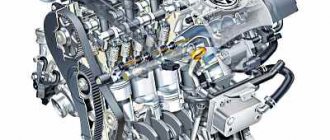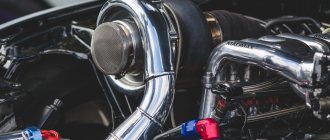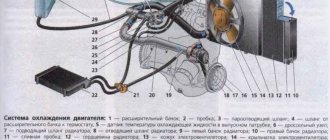Features of a rotary motor
The design is based on a triangular-shaped rotor, each of the faces of which has a convexity (Reuleaux triangle).
The rotor rotates in a planetary manner around a central axis - the stator. The vertices of the triangle describe a complex curve called an epitrochoid. The shape of this curve determines the shape of the capsule within which the rotor rotates. The rotary engine has the same four stroke cycles as its competitor, the piston engine.
Chambers are formed between the edges of the rotor and the walls of the capsule; their shape is variable crescent-shaped, which is the cause of some significant design flaws. To isolate the chambers from each other, seals are used - radial and end plates.
If we compare a rotary internal combustion engine with a piston one, the first thing that catches your eye is that during one revolution of the rotor, the power stroke occurs three times, and the output shaft rotates three times faster than the rotor itself.
The RPD does not have a gas distribution system
, which greatly simplifies its design.
And the high specific power with the small size and weight of the unit is a consequence of the absence of a crankshaft
, connecting rods and other interfaces between the chambers.
The structure and principle of operation of a rotary engine
The operating pattern of a rotary engine is something completely different from a conventional internal combustion engine. First, we must leave behind the design of the internal combustion engine as we know it. And secondly, try to absorb new knowledge and concepts.
Like a piston engine, a rotary engine uses pressure that is created by burning a mixture of air and fuel. In piston engines, this pressure is created in the cylinders and moves the pistons back and forth. The connecting rods and crankshaft convert the reciprocating motion of the piston into rotational motion, which can be used to turn the wheels of a car.
The RPD is named so because of the rotor, that is, the part of the motor that moves. Thanks to this movement, power is transferred to the clutch and gearbox. Essentially, the rotor pushes out energy from the fuel, which is then transferred to the wheels through the transmission. The rotor itself is made of alloy steel and has, as mentioned above, a triangle shape.
The capsule where the rotor is located is a kind of matrix, the center of the universe, where all processes take place. In other words, it is in this oval body that what happens:
- mixture compression;
- fuel injection;
- oxygen supply;
- ignition of the mixture;
- release of burnt elements to the outlet.
In a word, six in one, if you like.
The rotor itself is mounted on a special mechanism and does not rotate around one axis, but seems to run. Thus, cavities isolated from each other are created inside the oval body, in each of which one of the processes occurs. Since the rotor is triangular, there are only three cavities.
It all starts as follows: in the first cavity formed, suction occurs, that is, the chamber is filled with an air-fuel mixture, which is mixed here. After this, the rotor rotates and pushes this mixed mixture into another chamber. Here the mixture is compressed and ignited with the help of two candles.
The mixture then goes into the third cavity, where parts of the used fuel are displaced into the exhaust system.
This is the full cycle of RPD operation. But it's not that simple. We examined the RPD scheme only from one side. And these actions take place constantly. To put it differently, processes occur on three sides of the rotor at once. As a result, in just one revolution of the unit, three cycles are repeated.
Again, performance is not the only benefit of RPD. He has a lot of them. As mentioned above, the rotary engine is very compact and uses as many as a thousand fewer parts than the same internal combustion engine. There are only two main parts in the RPD - the rotor and the stator, and you can’t imagine anything simpler than that.
Design
To understand the principle of operation, you need to understand what the design of a rotary engine is. So, instead of pistons, the energy of fuel combustion in such a power unit is perceived by the rotor. The rotor has the shape of an equilateral triangle. Each side of this triangle plays the role of a piston.
Rotor
To ensure the combustion process, the rotor is placed in a closed space consisting of three elements - two side housings, and one central one, called the stator. The space in which the combustion process takes place is made in the stator; the side housings only ensure the tightness of this space.
Inside the stator there is a cylinder in which the rotor is located. In order for all the necessary processes to take place inside this cylinder, it is made in the form of an oval, with slightly pressed sides.
The stator itself has windows on one side for the intake of the air-fuel mixture or air, and the exhaust of exhaust gases. Opposite them there is a hole for the spark plugs.
Engine device
The peculiarity of the movement of the rotor in the stator cylinder is that its tops are constantly in contact with the surface of the cylinder; its movement is made according to the eccentric type. It not only rotates around its axis, but also shifts relative to it.
For this purpose, a large hole is made in the rotor; on one side of this hole there is a gear sector. On the other side, a shaft with an eccentric is inserted into the rotor.
To ensure rotation, a fixed gear is installed in the side housing, which meshes with the toothed sector of the rotor; it serves as a support point for it. During its eccentric movement, it rests on a fixed gear, and the gearing provides it with rotational movement. As it rotates, it also ensures rotation of the shaft with the eccentric on which it is mounted.
Duty cycle
The Wankel engine uses a four-stroke cycle:
- stroke A: The fuel-air mixture enters the engine chamber through the intake port
- stroke B: The rotor rotates and compresses the mixture, the mixture is ignited by an electric spark
- stroke C: Combustion products press on the rotor surface, transmitting forces to the cylindrical eccentric
- stroke D: The rotating rotor forces the exhaust gases into the exhaust port.
Despite the similarity of the cycle, the combustion dynamics of the fuel-air mixture in a rotary piston engine (RPE) are very different from a traditional piston engine.
In a piston engine (PE), the fuel-air charge, passing into the cylinder through the valve at the intake stage, acquires high turbulence, which increases with increasing crankshaft speed, which has a beneficial effect on the completeness of combustion of the mixture. In the RPD, turbulence is lower and at the moment of ignition, the main charge of the mixture ahead of the rotor rotation quickly burns out, while the rear part of the working cavity remains unburned and is released into the atmosphere. This explains the 6-8 times higher percentage of emissions of unburned hydrocarbons into the atmosphere compared to piston engines.
Another difference between the RPD operating cycle and the PD operating cycle is the shift in the moment of maximum heat release in the combustion chamber to the expansion line after passing top dead center. Therefore, the maximum cycle temperatures, at the same compression ratio, are lower for RPDs, and in the exhaust phase the temperature of the exhaust gases is 200 - 250 °C higher than for piston engines. This is thermodynamically unfavorable and leads to an additional decrease in efficiency, but at the same time, for this reason, the emission of nitrogen oxide from the RPD is 20% lower, and at the same compression ratios, the RPD is able to operate without detonation on fuel with an octane rating of 15 units less than the piston engine.
Elimination of the shortcomings of RPM is achieved by complicating injection systems, creating stratification of the fuel-air mixture in the combustion chamber, etc.[3]
Design and principle of operation
What is the operating principle of a rotary engine? This type of motor has a 4-stroke cycle, just like a classic internal combustion engine. However, the operating principle of a rotary piston engine is slightly different from that of a conventional piston engine.
What is the main feature of this motor? The rotary Stirling engine has in its design not 2, not 4 or 8 pistons, but only one. It's called a rotor. This element rotates in a specially shaped cylinder. The rotor is mounted on a shaft and connected to a gear. The latter has a gear clutch with the starter. The element rotates along an epitrochoidal curve. That is, the rotor blades alternately overlap the cylinder chamber. In the latter, fuel combustion occurs. The principle of operation of a rotary engine (including Mazda Cosmo Sport) is that in one revolution the mechanism pushes three petals of rigid circles. As the part rotates in the housing, the three compartments inside change size. Due to the change in size, a certain pressure is created in the chambers.
Operating principle of a rotary engine
The operating principle of a rotary piston engine once made many talented engineers raise their eyebrows in surprise. And today, the talented engineers of Mazda deserve all praise and approval. It's no joke, believe in the performance of a seemingly buried engine and give it a second life, and what a second life!
Sectional view of a rotary engine
Rotary motor rotor
Rotary engine chamber
The rotor has three convex sides, each of which acts as a piston. Each side of the rotor has a recess in it, which increases the speed of rotation of the rotor as a whole, providing more space for the air-fuel mixture. At the top of each face there is a metal plate, which forms the chambers in which the engine strokes occur. Two metal rings on each side of the rotor form the walls of these chambers. In the middle of the rotor there is a circle in which there are many teeth. They are connected to a drive, which is attached to the output shaft. This connection determines the path and direction that the rotor moves inside the chamber.
The engine chamber is approximately oval in shape (but to be more precise it is an Epitrochoid, which in turn is an elongated or shortened epicycloid, which is a flat curve formed by a fixed point on a circle rolling on another circle). The shape of the chamber is designed so that the three apexes of the rotor are always in contact with the chamber wall, forming three closed gas volumes. In each part of the chamber, one of four cycles occurs:
- Inlet
- Compression
- Combustion
- Release
The inlet and outlet openings are located in the walls of the chamber and there are no valves on them. The exhaust port is connected directly to the exhaust pipe, and the intake port is directly connected to the gas.
The output shaft has semicircular cam protrusions placed asymmetrically relative to the center, which means that they are offset from the centerline of the shaft. Each rotor fits onto one of these lugs. The output shaft is analogous to the crankshaft in piston engines. Each rotor moves inside the chamber and pushes its own cam.
Since the cams are installed asymmetrically, the force with which the rotor presses on it creates a torque on the output shaft, causing it to rotate.
Structure of a rotary engine
A rotary engine consists of layers. The twin-rotor engine consists of five main layers, which are held together by long bolts arranged in a circle. Coolant flows through all parts of the structure.
The center consists of two fuel supply chambers, one for each rotor. It also separates the two rotors so its outer surface is very smooth.
At the center of each rotor are two large gears that rotate around smaller gears and are attached to the motor housing. This is the orbit for rotating the rotor.
Of course, if the rotary engine had no disadvantages, then it would definitely be used in modern cars. It is even possible that if the rotary engine had been sinless, we would not have known about the piston engine, because the rotary engine was created earlier. Then the human genius, trying to improve the unit, created a modern piston version of the engine.
But unfortunately, the rotary engine has disadvantages. Such obvious mistakes of this unit include the sealing of the combustion chamber. In particular, this is due to insufficiently good contact of the rotor itself with the cylinder walls. When friction with the cylinder walls, the metal of the rotor heats up and, as a result, expands. And the oval cylinder itself also heats up, and even worse - the heating occurs unevenly.
If the temperature in the combustion chamber is higher than in the intake/exhaust system, the cylinder must be made of high-tech material installed in different places in the body.
In order for such an engine to start, only two spark plugs are used. No longer recommended due to the nature of the combustion chamber. The RPD is equipped with a completely different combustion chamber and produces power three-quarters of the working time of the internal combustion engine, and the efficiency is as much as forty percent. In comparison: for a piston engine the same figure is 20%.
Intake of the fuel-air mixture in a rotary engine
The intake of the mixture begins at the moment when one of the vertices of the rotor passes the inlet valve in the housing. At this time, the volume of the chamber expands, drawing the fuel-air mixture into its increasing space. The moment the next rotor tip passes the inlet port, the next stroke begins. Compression of the fuel-air mixture in a rotary engine As the rotor rotates, the volume of the mixture captured by the rotor decreases, which leads to an increase in pressure. Maximum pressure is formed at the moment when the fuel-air mixture is in the spark plug area.
Combustion of the fuel-air mixture
To ignite the mixture, as in a piston engine, spark plugs are used. They ignite the mixture simultaneously, that is, they work synchronously. Typically, two spark plugs are used for a rotary engine. The use of two spark plugs is due to the characteristics of the working volume. It seems to be stretched along the wall of the body, which is why it is more effective to use two candles so that the mixture burns more quickly and evenly. In the case of a single spark plug, the mixture will burn longer, so to speak gradually, which will significantly reduce the peak pressure during the explosion when igniting the fuel-air mixture. As a result, from the resulting pressure of the blast wave, a working force is obtained that turns the rotor on the eccentric of the shaft. Torque is transmitted to the output shaft. The rotor rotates to the exhaust outlet.
Exhaust gas emission
As soon as the rotor of one of its apexes crosses the boundary of the exhaust port, the emission of exhaust gases begins. The rotor, by inertia, and also through the second rotor, which operates asynchronously, continues to change its angle and moves its apex to the inlet. Here everything happens again from the intake stroke to the ejection stroke.
Design
Let's look at the main parts of the RPD:
- motor housing;
- rotor;
- output shaft.
Like any other internal combustion engine, the Wankel engine has a housing that includes the main working chamber, in our case oval-shaped.
The shape of the combustion chamber (oval) is due to the use of a triangular rotor, the edges of which, when in contact with the walls of the oval-shaped combustion chamber, form isolated closed contours. All the operation cycles of the RPD take place in these isolated circuits:
- inlet;
- compression;
- ignition;
- release.
This arrangement eliminates the need for intake and exhaust valves. The intake and exhaust ports are located on the sides of the combustion chamber, and are connected directly to the power supply and exhaust system.
The next component of a rotary motor is the rotor itself. In an RPD, the rotor performs the function of pistons in a conventional engine. The shape of the rotor is similar to a triangle with edges rounded outward and faces protruding inward. Rounding the edges of the rotor is necessary for better sealing of the combustion chamber. Sampling inside the face is needed to increase the volume of the combustion chamber, proper combustion of the fuel-air mixture and increase the rotor speed. At the top of each face and on its sides there are metal plates, the task of which is to seal the combustion chamber, similar to the piston rings of a classic internal combustion engine. Inside the rotor are teeth that rotate the drive, which in turn rotates the output shaft.
We recommend: Engine cleaner
A classic motor has a crankshaft; in an RPD, its function is performed by an output shaft. Relative to the center of the output shaft, there are cam protrusions in the shape of semicircles. The cam protrusions are asymmetrical with respect to the center and are clearly offset relative to the center of the axis. Each cam protrusion of the output shaft has its own rotor. The rotational motion of each rotor, transmitted to the cam lobe, causes the output shaft to rotate around its axis, which in turn creates torque on the output shaft.
Working strokes of the RPD
Let's now take a closer look at the operating principle of a rotary engine and the work processes occurring inside it. Like a classic engine, the Wankel engine has the same intake, compression, power stroke and exhaust strokes.
The intake stroke begins at the moment one of the apexes of the rotor passes through the intake channel of the engine housing. At this moment, a fuel-air mixture or just air is sucked into the gradually expanding combustion chamber, depending on the layout of the fuel supply system. With further rotation of the rotor to the point where the second vertex passes the inlet port, the compression stroke of the fuel-air mixture begins. The mixture pressure, along with the movement of the rotor, gradually increases and reaches its peak at the moment it passes the spark plug zone. At the moment of ignition, the rotor stroke begins.
Due to the special shape of the combustion chamber, elongated along the housing wall, it is advisable to use two spark plugs. The use of two spark plugs allows you to quickly and evenly ignite the fuel-air mixture, which guarantees fast, smooth and uniform propagation of the flame front.
A regular piston engine, for example, some sports engines, can have two spark plugs, but in an RPD, the use of two spark plugs is simply necessary.
The resulting gas pressure turns the rotor on the shaft eccentric, which in turn leads to the generation of torque on the output shaft. As the rotor top approaches the exhaust port, the pressure in the combustion chamber gradually decreases. Rotating by inertia, the top of the rotor reaches the exhaust channel, and the exhaust stroke begins. The exhaust gases rush into the exhaust port and once the tip of the rotor reaches the intake port, the intake stroke begins again.
Power system and lubrication
A rotary engine has no fundamental differences from a classic internal combustion engine in the ignition, fuel supply and cooling systems. However, the lubrication system has its own characteristics. To lubricate moving parts, oil is supplied directly into the combustion chamber through a special hole, so it burns together with the fuel-air mixture, just like in a two-stroke engine.
Like any technical design, a rotary motor has its advantages and disadvantages.
Rotary motor housing
The body of a rotary engine is like a multi-layer cake. It has its own lids, working chambers, and dividing walls. The best way to understand the design of the case is to look at the picture. It shows that the engine has two chambers separated by a wall and covers on both sides. Everything else, of course, also matters, but what we have listed is paramount. And now we will talk about the working chambers of the rotary engine housing.
The internal cavity of the body has a complex shape, resembling an oval. In fact, the oval has certain compensating ebbs that ensure the sealing of all three chambers separated by the rotor, regardless of the angle of rotation and the ongoing cycle. Each cycle has its own place in the rotary engine housing. Depending on the angle of rotation of the rotor, a corresponding cycle is performed, which is repeated at intervals every 360 degrees of rotation of the rotor. The outlets for the emission of burnt gases are also located in the body of the working chamber. Intermediate wall between the chambers (pictured below)
holds the shaft in its central hole, is sealed with the rotors along the side walls, has elements of the cooling system, injection ports, and guide bushings.
Work phases
How does a rotary engine work? The operating principle (gif images and RPD diagram you can see below) of this motor is as follows. The operation of the engine consists of four repeating cycles, namely:
- Fuel supply. This is the first phase of engine operation. It occurs at the moment when the top of the rotor is at the level of the feed hole. When the camera is open to the main compartment, its volume approaches its minimum. As soon as the rotor rotates past it, the fuel-air mixture enters the compartment. After this, the camera becomes closed again.
- Compression. As the rotor continues to move, the space in the compartment decreases. Thus, the mixture of air and fuel is compressed. As soon as the mechanism passes the compartment with the spark plugs, the volume of the chamber decreases again. At this moment, the mixture ignites.
- Ignition. Often a rotary engine (including VAZ-21018) has several spark plugs. This is due to the large length of the combustion chamber. As soon as the candle ignites the combustible mixture, the pressure level inside increases tens of times. Thus, the rotor is driven again. Further, the pressure in the chamber and the amount of gases continue to increase. At this moment, the rotor moves and torque is created. This continues until the mechanism passes the exhaust compartment.
- Release of gases. When the rotor passes this compartment, high-pressure gas begins to move freely into the exhaust pipe. In this case, the movement of the mechanism does not stop. The rotor rotates steadily until the volume of the combustion chamber again drops to a minimum. By this time, the remaining amount of exhaust gases will be squeezed out of the engine.
This is exactly the operating principle of a rotary engine. The VAZ-2108, on which the RPD was also mounted, like the Japanese Mazda, was distinguished by quiet engine operation and high dynamic characteristics. But this modification was never put into mass production. So, we found out what the operating principle of a rotary engine is.
About the combustion of a rotary diesel engine
The RDD cannot operate otherwise than in diesel mode, i.e. with fuel injection directly into the combustion chamber. The combustion chamber is separated from other cavities, and this has its advantages, for example, paradoxically (in comparison with KShDD) a reduction in heat losses at the moment of highest pressure in the combustion chamber, in which they (losses) are most intense, because heat transfer occurs through the surface, in the RDD the ratio of the surface area of the combustion chamber to its volume is equal to = 2.4, and in the compared KShDD in an identical position corresponding to the top dead center it is = 3.8. In addition, the very intensity of heat transfer in a real RDD is supposed to be reduced by partial thermal insulation of the combustion chamber. In the expansion chamber, of course, this coefficient is higher, but the intensity of heat transfer in it is lower. Possible pressure losses are taken into account in the calculations by reducing the pressure increase coefficient by 20% (a figure deliberately overestimated) and taken equal to = 1.9 compared to the KSHDD, for which it was taken = 2.4.
The quality of mixture formation in the RDD will be better due to the fact that the combustion chamber is always in a hotter state than in the KSHDD, the evaporation of fuel that gets on the walls will be more intense and complete, the required time for complete combustion of the fuel and the required excess air ratio are easily ensured .
The complex of these factors guarantees more complete combustion of fuel and the formation of fewer harmful substances compared to KSHDD.
Rotary motor output shaft
The output shaft has eccentrics, in this case there are two of them, since two rotors are installed on the shaft, which operate in antiphase, when one is in the exhaust gas emission cycle, the second in the mixture intake cycle. The use of two rotors makes it possible to compensate for beating during engine operation and, accordingly, reduce detonation. By displacing the eccentric and moving each of the rotors along the walls in the engine housing, they try to rotate the shaft. As a result, a working torque is generated on it.
Advantages of a rotary engine
Fewer moving parts
A rotary engine has many fewer parts than say a 4 cylinder piston engine. A twin rotor engine has three main moving parts: two rotors and an output shaft. Even the simplest 4-cylinder piston engine has at least 40 moving parts, including pistons, connecting rods, rods, valves, rockers, valve springs, timing belts, and the crankshaft. Minimizing moving parts allows rotary engines to achieve higher reliability. This is why some aircraft manufacturers (for example Skycar) use rotary engines instead of piston engines.
Softness
All parts in a rotary engine rotate continuously in one direction, unlike the constantly changing direction of the pistons in a conventional engine. The rotary engine uses balanced rotating counterweights to suppress any vibrations. The power delivery in a rotary engine is also smoother. Each combustion cycle occurs in one rotor revolution of 90 degrees, the output shaft rotates three times for each rotation of the rotor, each combustion cycle occurs in 270 degrees during which the output shaft rotates. This means that a single rotary engine produces three-quarters of the power. Compared to a single cylinder piston engine, combustion occurs every 180 degrees of every revolution, or only a quarter revolution of the crankshaft.
Slowness
Because the rotors rotate at one-third of the rotation of the output shaft, the main parts of the engine rotate more slowly than those in a conventional piston engine. This also helps with reliability.
Small dimensions + high power
The compactness of the system, together with high efficiency (compared to a conventional internal combustion engine), allows the miniature 1.3-liter engine to produce about 200-250 hp. True, along with the main design flaw in the form of high fuel consumption.
Disadvantages of rotary motors
The most important problems in the production of rotary engines:
- It is quite difficult (but not impossible) to comply with regulations on CO2 emissions into the environment, especially in the USA.
- Production can be much more expensive, in most cases due to low volume production, compared to piston engines.
- They consume more fuel because the thermodynamic efficiency of a piston engine is reduced in a long combustion chamber and also due to the low compression ratio.
- Rotary engines due to their design have a limited service life - on average it is about 60-80 thousand km
This situation simply forces rotary engines to be classified as sports car models. And not only. Today there are supporters of the rotary engine. This is the famous automaker Mazda, which took the path of the samurai and continued the research of Master Wankel. If we remember the same situation with Subaru, then the success of Japanese manufacturers becomes clear, clinging, it would seem, to everything old and discarded by Westerners as unnecessary. But in fact, the Japanese manage to create new things out of old ones. The same thing happened then with boxer engines, which are today Subaru’s “feature.” At the same time, the use of such engines was considered almost a crime.
The work of the rotary engine also interested Japanese engineers, who this time set about improving the Mazda. They created the 13b-REW rotary engine and equipped it with a twin-turbo system. Now Mazda could easily compete with German models, since it offered as many as 350 horses, but again suffered from high fuel consumption.
Surprisingly, they tried to introduce RPD in our country. Such an engine was designed for installation on the VAZ 21079, intended as a vehicle for special services, but the project, unfortunately, did not take root. As always, there was not enough state budget money, which is miraculously siphoned out of the treasury.
But the Japanese managed to do it. And they don’t want to stop there. According to the latest data, the Mazda manufacturer will improve the engine and a new Mazda will soon be released, with a completely different unit.
Small resource
The main and most significant drawback is the short service life of the engine. On average, it is equal to 100 thousand kilometers for Russia. In Europe, the USA and Japan, this figure is twice as high, thanks to the quality of fuel and competent maintenance.
The highest load is experienced by metal plates, apexes - radial end seals between the chambers. They have to withstand high temperature, pressure and radial loads. On the RX-7, the apex height is 8.1 millimeters, replacement is recommended when wear reaches 6.5, on the RX-8 it was reduced to 5.3 factory values, and permissible wear is no more than 4.5 millimeters.
It is important to monitor compression, the condition of the oil and the oil injectors that supply lubricant to the engine chamber. The main signs of engine wear and impending major overhaul are low compression, oil consumption and difficult hot starting.
Low environmental friendliness
Since the lubrication system of a rotary piston engine involves direct injection of oil into the combustion chamber, and also due to incomplete combustion of fuel, exhaust gases have increased toxicity. This made it difficult to pass the environmental inspections that had to be met in order to sell cars in the American market.
To solve the problem, Mazda engineers created a thermal reactor that burned hydrocarbons before releasing them into the atmosphere. It was first installed on a Mazda R100.
Instead of shutting down production like others, Mazda began selling vehicles with the Rotary Engine Anti-Pollution System (REAPS) in 1972.
Advantages and disadvantages of a rotary engine
For the first time, a car with a rotary power unit entered the track for testing in 1958. At the origins of its creation is Felix Wankel the RPD is often called .
Ignoring the merits of the invention of the German engineer, who worked on it together with like-minded colleague Walter Freude , many automakers did not dare to install the new product on the production models of their cars.
This does not include Mazda , which released the first version of the vehicle with a rotary powerplant in 1967.
Advantages of RPD
Pros of RPD:
- High efficiency, reaching 40%! Rationale - for 1 revolution of the eccentric shaft there are 3 working cycles.
- Simplified design. It lacks many components characteristic of piston internal combustion engines, incl. gas distribution mechanism, connecting rods, valves, etc.
- High speed. The engine based on a triangular rotor element spins up to 10 thousand rpm.
- Smooth operation with complete absence of vibrations. The explanation is the stable orientation of the rotor movement in one direction.
- Resistance to detonation. This allows the use of hydrogen during operation.
- Compact sizes. Compared to piston units, the dimensions of the RPD are 2 times smaller. The consequence of this is the low weight of the fully equipped structure and the availability of free space for a comfortable position of the driver and passengers.
- No additional loads when the number of revolutions increases. Taking into account this factor, you can accelerate the vehicle to 100 km/h in low gear.
- Balance. Allows you to more effectively balance the car, creating stable stability on any road surface.
We recommend: Which light bulbs to choose for your car
Disadvantages of RPD
The designers who developed the rotary power plant were unable to eliminate the shortcomings:
- Motorists consider the main flaw of the creators to be the limited service life of the engine , justified by the design features. Constant changes in the working angle of the apexes cause their accelerated wear.
- The service life ends faster due to temperature changes that accompany each stroke . In combination with the loads to which the rubbing parts are exposed, they cause irreparable damage to functional components and materials. The problem can be solved by direct injection of mineral lubricant into the manifold.
- Since the internal cavities of the chambers are crescent-shaped, the fuel in them is not completely burned . The rotor, rotating at a speed with a limited stroke length, pushes hot gases into the exhaust port. The presence of oil fragments in combustion products leads to toxic emissions .
- Insufficient tightness of the structure caused by wear of the seals is the cause of leakage between compartments with large pressure differences between compartments. The result is a decrease in efficiency and increased harm to the environment.
- High consumption of fuel and lubricants . Compared to a piston engine, a rotary unit consumes much more fuel (20 liters per 100 km) and oil (1 liter per 1 thousand km). The forgetfulness of the driver, who missed the next lubrication refill, leads to unplanned major repairs or a complete replacement of the engine.
- High-precision equipment is used for the production of RPD. There are also increased demands on the quality of materials. As a result, the final cost of the rotary engine increases.
Difficulty in producing parts
In addition, it is worth noting the high cost of producing parts for this engine, which was explained by the complexity of manufacturing the rotor. In order for this mechanism to correctly pass the epitrochoidal curve, high geometric accuracy is needed (including for the cylinder). Therefore, in the manufacture of rotary engines it is impossible to do without specialized expensive equipment and special knowledge in the technical field. Accordingly, all these costs are included in the price of the car in advance.
Overheating and high loads
Also, due to the special design, this unit was often subject to overheating. The whole problem was the lens-shaped shape of the combustion chamber.
In contrast, classic internal combustion engines have a spherical chamber design. The fuel that burns in the lens-shaped mechanism is converted into thermal energy, which is spent not only on the working stroke, but also on heating the cylinder itself. Ultimately, frequent “boiling” of the unit leads to rapid wear and failure.
Disadvantages of a rotary piston engine
- Let's start with perhaps the most important disadvantage, this is the incredibly short service life of the engine. On average, these figures do not exceed 200 thousand km.
- Expensive. Since the manufacture of RPD requires the most precise equipment to perform precise work on parts, the price of spare parts and the motors themselves is initially very high. Therefore, RPD is much more expensive than a classic internal combustion engine.
- Change of oil. Nothing good with oil either. The motor is very sensitive and requires a lot of attention. The oil should be changed every 5 thousand km, or even more often. You also have to add oil regularly, consumption per thousand km is from 400 to 1000 ml.
- High fuel consumption. With a volume of 1.3 liters, this monster, in the combined cycle, consumes 15-20 liters of gasoline per 100 km.
- High exhaust toxicity. Due to the fact that some of the oil burns with the air-fuel mixture, too dirty an exhaust is released into the atmosphere.
- Great tendency to overheat. This is due to the shape of the RPD combustion chamber.
- Frequent replacement of combustion chamber seals due to the high impact of the rotor.
So we looked at the pros and cons of RPD. It is impossible to say that a rotary piston engine is a bad engine, because its performance and efficiency speak for themselves, but due to some design flaws, or rather its unusualness, there are a number of disadvantages. Of course, over the years, this is all resolved and when the proper materials become available, the quality of these engines will only grow. But so far the RPD is far from perfect.
Do you have a question or comment?
Write! Click to cancel reply.
Resource
It's not just the cylinder that bears heavy loads. Studies have shown that during rotor operation, a significant part of the load falls on the seals located between the nozzles of the mechanisms. They are subject to a constant pressure drop, so the maximum engine life is no more than 100-150 thousand kilometers.
After this, the engine requires major repairs, the cost of which is sometimes equivalent to purchasing a new unit.
Oil consumption
Also, the rotary engine is very demanding on maintenance.
Its oil consumption is more than 500 milliliters per 1 thousand kilometers, which forces you to fill in fluid every 4-5 thousand kilometers. If you do not replace it in time, the motor will simply fail. That is, the issue of servicing a rotary engine needs to be approached more responsibly, otherwise the slightest mistake can lead to costly repairs of the unit.
Varieties
At the moment, there are five varieties of these types of units:
- Rotary motors with reciprocating rotational movements of the shaft.
- With uniform shaft rotation. Moreover, its design does not use any sealing mechanisms. The combustion chambers are arranged in a spiral type.
- Units with pulsating-rotational movement directed in one direction.
- With planetary shaft rotation, without sealing elements. A striking example of this is the Wankel engine.
- RPD with uniform operation of working elements and a spiral type of arrangement of combustion chambers.
Now let's look at the pros and cons of a rotary piston engine, starting with the pros:
- A rotary piston engine has maximum output and efficiency is 45%; for comparison, for a diesel internal combustion engine this figure is about 40%, and for a gasoline internal combustion engine even less - 30%.
- Minimum vibration level. This is due to the fact that the rotor moves in a circle and does not make reciprocating movements like a classic internal combustion engine. Plus the RPDs are well balanced.
- RPDs have excellent dynamic characteristics, high power and good torque. So, with a volume of 1.3 liters, the engine has a power rating of 231 hp and a torque of 210 Nm.
- Compactness. Due to the simplicity of the design and the reduced number of parts to a minimum, such motors are very compact and have very low weight.
Based on the above, we can say that the rotary piston engine is very good and is quite capable of competing with classic engines. But not everything is as simple as it seems. Let's look at the disadvantages of RPD.
Rotary engine (VAZ-21018-2108)
The history of the creation of VAZ rotary internal combustion engines dates back to 1974. It was then that the first RPD design bureau was created. However, the first engine developed by our engineers had a similar design to the Wankel engine, which was equipped on imported NSU Ro80 sedans. The Soviet analogue was called VAZ-311. This is the very first Soviet rotary engine. The principle of operation of this engine on VAZ cars has the same algorithm of operation of the Wankel RPD.
The first car on which these engines began to be installed was the VAZ modification 21018. The car was practically no different from its “ancestor” - model 2101 - with the exception of the internal combustion engine used. Under the hood of the new product was a single-section RPD with a capacity of 70 horsepower. However, as a result of research on all 50 model samples, numerous engine failures were discovered, which forced the Volzhsky Plant to abandon the use of this type of internal combustion engine on its cars for the next few years.
The main reason for malfunctions of the domestic RPD was unreliable seals. However, Soviet designers decided to save this project by presenting to the world a new 2-section rotary engine VAZ-411. Subsequently, the VAZ-413 brand internal combustion engine was developed. Their main differences were in power. The first copy developed up to 120 horsepower, the second - about 140. However, these units were again not included in the series. The plant decided to install them only on official vehicles used by the traffic police and the KGB.
History of the creation of a rotary engine
The second name of the rotary engine (RPE) is Wankel (a kind of analogue of a diesel engine).
It is Felix Wankel who today is credited with the laurels of the inventor of the rotary piston engine, and even a touching story is told about how Wankel walked towards his goal at the same time as Hitler walked towards his. In fact, everything was a little different: a talented engineer, Felix Wankel, really worked on developing a new, simple internal combustion engine, but it was a different engine based on the joint rotation of rotors.
After the war, Wankel was recruited by the German company NSU, which was mainly involved in the production of motorcycles, to one of the working groups working on the creation of a rotary engine under the leadership of Walter Freude.
Wankel's contribution was extensive research into rotary valve seals. The basic design and engineering concept are Freud's. Although Wankel had a patent for dual rotation.
The first engine had a rotating chamber and a stationary rotor. The inconvenience of the design suggested the idea of changing the layout.
The first rotating rotor engine began operation in mid-1958. It differed little from its descendant of our days - except that the candles had to be moved to the body.
Felix Wankel and his first rotary engine
Soon the company announced that it had managed to create a new and very promising engine. Almost a hundred car manufacturing companies have purchased licenses to produce this engine. A third of the licenses ended up in Japan.
Rules for operating a rotary engine
Experts recommend adhering to the following rules when servicing:
- Change the oil every 3-5 thousand kilometers. A consumption of 1.5 liters per 1000 km is considered normal.
- monitor the condition of oil injectors; their average life is 50 thousand.
- change the air filter every 20 thousand.
- use only special spark plugs, resource 30-40 thousand kilometers.
- Fill the tank with gasoline no lower than AI-95, and better yet AI-98.
- measure compression when changing oil. For this, a special device is used; the compression should be within 6.5-8 atmospheres.
When operating with compression below these values, a standard repair kit may not be enough - you will have to replace an entire section, and possibly the entire engine.
World famous cars produced with rotary engines
The Japanese company Mazda was a pioneer in the development of production cars with rotary engines. So the first Mazda Cosmo Sport was released back in 1967. The next generation, the Mazda RX-7, went on sale in 1978. Perhaps it was one of the most successful cars with a rotary engine. And the latest generation of cars with a rotary engine is the Mazda RX-8. And as a result, the most powerful non-turbocharged internal combustion engine was the Renesis engine from Mazda, with a volume of only 1.3 liters. It has a record power to engine displacement, namely 250 hp. With. In recent years, Mazda has managed to significantly improve the performance of rotary engines. Engines have become more environmentally friendly and do not require as much oil for lubrication. Other car manufacturers also produced cars with rotary engines: Audi, Mercedes. In the USSR, AvtoVAZ also produced a number of rotary engines. Rotary engines were installed on car 21079 (1.3 l 140 hp) and were planned for use in special services. In the 90s, the following rotary engines VAZ-416, VAZ-426, VAZ-526 were created at the VAZ Scientific and Technical Center.
Sources
- https://dolauto.ru/informations/articles/chto-takoe-rotornyy-dvigatel/
- https://krossovery.info/princip-raboty-rotornogo-dvigatelya-plyusy-i-minusy-sistemy/
- https://autoleek.ru/dvigatel/dvs/ustrojstvo-rotornogo-dvs.html
- https://ru.wikipedia.org/wiki/%D0%A0%D0%BE%D1%82%D0%BE%D1%80%D0%BD%D0%BE-%D0%BF%D0%BE% D1%80%D1%88%D0%BD%D0%B5%D0%B2%D0%BE%D0%B9_%D0%B4%D0%B2%D0%B8%D0%B3%D0%B0%D1% 82%D0%B5%D0%BB%D1%8C
- https://zen.yandex.ru/media/halva/rotornyi-dvigatel-princip-raboty-i-tehnika-primeneniia-5ba095896ee05400aa942a3c
- https://www.syl.ru/article/158520/new_rotornyiy-dvigatel-printsip-rabotyi-plyusyi-i-minusyi-rotornogo-dvigatelya
- https://ZnanieAvto.ru/dvs/rotornyj-dvigatel-vnutrennego-sgoraniya.html
Machines with rotary engine
Russian designers, including Zuev , Zheltyshev , and Ingush inventors the Akhriev brothers, also participated in the development of improved concepts of the power unit with a basic design element in the form of a movable rotor.
Ignoring innovation, Wankel engines are still installed on cars.
Models with RPD include:
- Mazda RX-8. The design bureau of the Japanese concern has made progress in improvement. Their latest development, with a capacity of 1.3 liters, produces 215 hp . A later version with a similar displacement produces 231 hp. Production has ceased since August 2011 as a result of decreased demand.
- VAZ 2109-90. Such machines were used for official purposes by Russian law enforcement officers. Police cars could accelerate to 100 km/h in 8 seconds and reach a speed of 200 km/h , easily catching up with criminals. Units with greater power were also produced. But the high price and low resource did not allow the RPD to take root, and the police had to switch to vehicles with piston engines.
- Mercedes S-111. It was first presented to car enthusiasts at the Geneva Motor Show in 1970 . The sports car was equipped with a three-chamber Wankel engine. The maximum speed was 275 km/h . It took 5 seconds to accelerate to the first hundred .
- VAZ 21019 Arkan. The model was also purchased for the needs of the Ministry of Internal Affairs. It was impossible to catch up with Soviet policemen in such cars, much less evade pursuit. Most pursuits resulted in the capture of the criminals. The explanation for this is the ability of official vehicles to reach a maximum speed of 160 km/h. The three-section 1.3 liter engine produced 120 hp.
